
Resources
What is Connecticut’s definition of a paraprofessional?
A paraprofessional is an employee who assists teachers and/or other professional educators or therapists in the delivery of instructional and related services to students. The paraprofessional works under the direct supervision of the teacher or other certified or licensed professional. The ultimate responsibility for the design, implementation, and evaluation of instructional programs, including assessment of student progress, is a collaborative effort of certified and licensed staff.
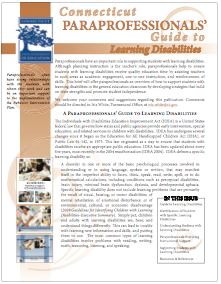
- Guide to Learning Disabilities
- Identification of Students with Specific Learning Disabilties
- Understanding Students with Learning Disabilities
- Paraprofessionals Providing Instructional Support
- Supporting Students with Learning Disabilities
Download PDF
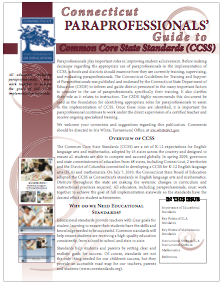
- Importance of Educational Standards
- Key Points of ELA Standards
- Key Points of Mathematics Standards
- Instructional Shifts in ELA /Mathematics
Download PDF
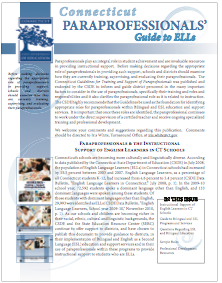
- Instructional Support of English Language Learners in CT
- Guide to Bilingual and ESL Programs and Services
- Questions Regarding ESL and Bilingual Education
- Sample Roles
- Professinal Development Resources
Download PDF
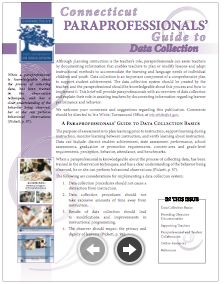
- Data Collection Basics
- Providing Objective Documentation
- Supporting Teachers
- Paraprofessional and Teacher Collaboration
- Online Resources
Download PDF
- Guide to Challenging Behavior
- Understanding Challenging Behaviors
- Functional Behavior Assessment (FBA)
- A Good BIP
- Building Strong and Positive Relationships
- De-escalation
Download PDF
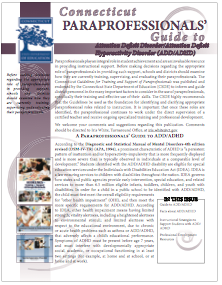
- Guide to ADD/ADHD
- Facts about ADD/ADHD
- Instructional Strategies to Support Students with ADD/ADHD
- Professional Development Resources
Download PDF
The Connecticut Guidelines for Training and Support of Paraprofessionals was published and endorsed by the Connecticut State Department of Education (CSDE) to inform and guide district personnel in the many important factors to consider in the use of paraprofessionals, specifically their training and effective use of their skills. The CSDE highly recommends that the Guidelines be used as the foundation for identifying and clarifying appropriate paraprofessional roles related to instruction. It is important that once these roles are identified, the paraprofessional continues to work under the direct supervision of a certified teacher and receive ongoing specialized training and professional development.
This Walkthrough Protocol covers IEP Implementation, Use of Supplementary Aids and Services and Best Practices in the Instruction of Students with Disabilities in NON-INSTRUCTIONAL Settings.
This Walkthrough Protocol covers IEP Implementation, Use of Supplementary Aids and Services and Best Practices in the Instruction of Students with Disabilities in INSTRUCTIONAL Classes.
More...
About the P.J. ET AL v. State of Connecticut, Board of Education, ET AL Settlement Agreement
1. Does the Settlement Agreement apply to students who do not have an intellectual disability? If my child has multiple disabilities, including an intellectual disability, is she/he a class member?
The Settlement Agreement only addresses students who have an intellectual disability, but the federal and state special education laws are the same for all students with disabilities. The requirements to place all students with disabilities in the least restrictive environment, where she/he can receive an appropriate education, are the same for all students. Placement in the regular education classroom, with the appropriate supports and services, must be the first consideration for all students. A child who is identified as having multiple disabilities, as their primary disability, is not a class member.
2. Does the Settlement Agreement apply to pre-K or preschool students?
The Settlement Agreement specifically defines class members as school-aged children. The Connecticut State Department of Education (CSDE) has agreed to include preschoolers with an intellectual disability in the data analysis and goal setting, which in effect makes them members of the class. The law requires that preschool-age children be educated in the least restrictive environment. The CSDE collects data on preschool-age students, the amount of time a preschool student spends with non-disabled students, and the location where preschool-age students receive their services.
3. Does the Connecticut State Department of Education require districts to bring all students from out-of-district placements back to the district?
No. One of the five goals of the Settlement Agreement is to increase the percent of students with an intellectual disability who attend the school they would attend if not disabled (home school). It is not a requirement that all students return to a district school.
4. Is the Connecticut State Department of Education trying to close down the private special education or RESC programs?
No. School districts are required to maintain a continuum of options for placement for students with disabilities. This includes, when appropriate, private special education schools or RESC programs.
5. How does the CSDE monitor each district on the goals of the Settlement Agreement?
The CSDE monitors each district in a variety of ways, including:
- Reviewing data submitted by each school district on an annual basis;
- Reviewing data for targeted school districts on a quarterly basis;
- Conducting desk audits or on-site visits to monitor a district's improvement plan in the area of least restrictive environment (LRE);
- Conducting on-site visits, observations, record reviews, and data verification visits; and
- Responding to parent complaints.
6. How does a local district deal with a regular education teacher who does not want a child with an intellectual disability in his/her class?
Sometimes, teachers do not want a child in their classroom because they feel they are not equipped to meet the child's individual needs. Training and technical assistance is offered in districts and throughout the state on the requirement for all students with disabilities to be appropriately educated in the least restrictive environment. The Individualized Education Program (IEP) can identify training of staff as a requirement for students to be educated in the regular classroom. The IEP also identifies which modifications are needed for a student based on his/her individual needs. The principal of the school is essential in his/her leadership role supporting students in the regular education classroom, as well as ensuring staff are appropriately trained and supported.
7. What training is provided for regular education teachers? What is provided for special education teachers?
Professional development opportunities are offered for all teachers through local and statewide training. Local districts are required to provide professional development activities throughout the year. Many districts have chosen to use this time to address training for all staff on including students with disabilities in regular education classrooms. SERC also provides extensive professional development statewide, including programs by national experts on the topic of LRE. All districts have been offered a self-assessment tool called the School Based Practices Profile. This tool allows districts to identify their areas of strength and need in the area of LRE in order to determine what training and supports are required for staff and students. Districts may also choose to bring in private consultants to assist with district needs and with meeting the needs of individual students.
8. How do you determine what supports and services are needed in the regular education class?
Supports and services should be discussed at the Planning and Placement Team (PPT) meeting. It is a decision that should be determined individually for each child on the basis of the following:
- Evaluations;
- Input from parents and whomever they choose to have attend the PPT;
- Input from staff;
- Past and present performance;
- Past and present supports;
- Review of what has worked for children with particular needs;
- Requirements of the general education curriculum; and
- Information from professionals, both regular education and special education, who have experience placing children with intellectual disabilities in regular classes.
9. If a child with an intellectual disability is in a regular education class, do they need a one-on-one paraprofessional?
As with other decisions regarding supports and services, this is determined by the PPT. In some cases, relying on a paraprofessional may result in the student depending on one adult instead of engaging and learning with his/her classmates and the regular education teacher. Paraprofessional support can be an option; however, this support may be needed only for specific activities or times of the day, rather than all day.
There are many other supports that can be utilized instead of a paraprofessional. Some examples of these supports are: co-taught classrooms (regular education and special education teachers); therapist support in the classroom; peer support; small group instruction; providing staff training; and creating regularly scheduled collaboration time for team members.
10. Should high school students with an intellectual disability be included in academic classes such as algebra, chemistry, and regular education English?
The law requires that education in regular classes including algebra, chemistry, English, and all other high school courses of study, with the use of supplementary aids and services, must be considered for all students. Considerations must be made as to what supports, accommodations, and modifications would be needed for meaningful participation in regular academic classes, while ensuring receipt of a free, appropriate public education (FAPE.) The decision as to which classes a student should attend is made at the PPT. This decision is based on the student's strengths, needs, preferences, and long-term goals.
11. If a student is placed in a regular education classroom, does that mean they must take the standard form of the CMT or CAPT test?
Students have two options with respect to the Connecticut Mastery Test (CMT) or Connecticut Academic Performance Test (CAPT). The PPT may choose the alternate assessment (Skills Checklist) or the regular test. The United States Department of Education anticipates that only those students with the most significant cognitive disabilities will be assessed using the alternate assessment. There is a list of approved accommodations that the team can consider for students taking the regular test. This decision should be based on the student's individual needs and abilities, and the guidelines provided by the CSDE.
12. What types of supports are available for students participating in extracurricular activities? Are extracurricular activities part of the IEP?
The federal law, the Individuals Disabilities Education Act (IDEA), states that "each public agency shall take steps to provide nonacademic and extracurricular services and activities in the manner necessary to afford children with disabilities an equal opportunity for participation in those services and activities." A student's participation in school-sponsored extracurricular activities should be discussed at a PPT meeting. Districts must ensure that the student has access to the activities. The PPT should carefully consider supports needed for the student to participate. These supports should be listed on page 8 of the IEP: Program Modifications/Adaptations - Including Nonacademic and Extracurricular Activities/Collaboration/Support for School Personnel. Given the different environment and demands of these activities, these supports may or may not mirror those required during the school day.
When participation in an extracurricular activity is necessary to address goals and objectives, it should be identified on the IEP. In such instances, supports must be provided in order for the child to participate, including transportation and staffing.
13. Should a district return a student to their home school if they have attended a different school in the district for multiple years?
The law states that "unless the IEP requires some other arrangement, children are educated in the school she or he would attend if they did not have a disability." This applies to students with any disability, including students with an intellectual disability. This is a decision that is made on an individual student basis by the PPT. A PPT may decide that certain students should remain in out-of-district programs if they are close to finishing their educational career, and have been educated in that setting for a long time. Though it remains the goal for all students, including students with an intellectual disability, to attend their home school, there are times when it may be appropriate for a student to be educated in another setting. For example, some teams, based on the need for continuity for an individual student, have determined that a student should spend one more year in a nonhome school, and transition the following year, due to the timing of a natural transition (i.e., transition to middle or high school). Sometimes, it may be appropriate for the transition to take place over a period of time, such as an entire school year. In some instances, based on the student's individualized needs, the PPT may determine that it is not appropriate for the student to attend his/her home school, although this should be periodically reassessed.
14. Does the Settlement Agreement change the law for students who require special education services?
No, the Settlement Agreement does not change either state or federal special education laws. The Settlement Agreement supports and strengthens the intent of the laws that all children, regardless of their disability label, be educated to the maximum extent appropriate with their nondisabled peers in the least restrictive environment. The Settlement Agreement requires Connecticut to make meaningful annual progress in increasing the placement of students with intellectual disabilities in regular classes in their home schools, and in their participation in extracurricular activities.
Moving Forward with Responsible Inclusive Practice in Connecticut Schools: Ensuring that Students with Disabilities are Educated in the Least Restrictive Environment
A Settlement to P.J. et al v State of Connecticut, Board of Education, et al(This synopsis is not intended to be an official representation of the Agreement’s content, but done in an effort to inform persons of the major aspects of the Agreement. There is no intention to misrepresent or not to inform persons of the Agreement’s content.)
In 1991, a case was filed by five school-age children with mental retardation and their families. It was certified as a class action lawsuit on December 13, 1993. The class membership includes all school-age children with the label mental retardation/intellectual disability on or after February 20, 1991 who are not educated in regular classrooms.
The settlement to P.J. et al (Plaintiffs) v State of Connecticut Board of Education, et al (Defendants) was approved by the federal court on May 22, 2002. The agreement provides that the Connecticut State Department of Education (CSDE) demonstrate progress each year in the following goals and outcomes:
- an increase in the percent of students with mental retardation or intellectual disability who are placed in regular classes, as measured by the federal definition (i.e., eighty [80] percent or more of the school day with nondisabled students);
- a reduction in the disparate identification of students with mental retardation or intellectual disability by LEA, by racial group, by ethnic group, or by gender
- an increase in the mean and median percent of the school day that students with mental retardation or intellectual disability spend with nondisabled students;
- an increase in the percent of students with mental retardation or intellectual disability who attend the school they would attend if not disabled (i.e., “home school”);
- an increase in the percent of students with mental retardation or intellectual disability who participate in school-sponsored extracurricular activities with nondisabled students.
Among the specific responsibilities of the CSDE was the development of policy statements. The Commissioner of Education issued a policy letter that reiterates the State Board of Education’s position, which affirms the right of each child with intellectual disabilities (formerly labeled mental retardation) or other disability to be educated with non-disabled children to the maximum extent appropriate. The Chief of the Bureau of Special Education and Pupil Services of the CSDE issued a policy memorandum with further information regarding:
- the individual student decision- making process that must be followed by the Planning and Placement Team (PPT);
- the CSDE’s responsibilities for oversight of LEA activities to ensure compliance; and
- the joint state and local obligation to work toward greater inclusion of students with mental retardation in all aspects of the school program.
Each superintendent of schools, LEA school board member, special education due process hearing officer, and teacher preparation program in Connecticut received these policy memorandums along with a copy of the Agreement.
For further information about the Agreement, please contact Nikki Hendry, Consultant, SERC (860) 632-1485 ext. 255, This email address is being protected from spambots. You need JavaScript enabled to view it..
For information about activities for families of students with intellectual disabilities contact the Connecticut Parent Advocacy Center (CPAC), 1-800-445-2722, This email address is being protected from spambots. You need JavaScript enabled to view it., or visit www.cpacinc.org.
(This synopsis is not intended to be an official representation of the Agreement’s content, but done in an effort to inform persons of the major aspects of the Agreement. There is no intention to misrepresent or not to inform persons of the Agreement’s content. Originally posted 8/26/02. Updated on 11/19/15).
This resource manual provides strategies to systematically implement Assistive Technology (AT) services in High Schools. The strategies focus on assisting High Schools to deliver Assistive Technology services by:
- creating and sustaining school- and district-wide AT teams;
- providing AT services;
- monitoring and evaluating services to ensure that students with disabilities can access, participate in and make progress in general education curriculum.
The Connecticut AT Guidelines help to define the process for considering, implementing, and evaluating technologies that equalize the learning experience for students of all abilities.

